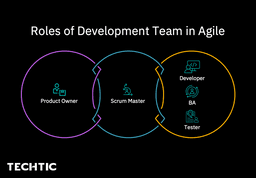Role of Development Team in an Agile Environment
Sector: Digital Product
Author: Nisarg Mehta
Date Published: 04/18/2022

- What is the Agile Software Development Life Cycle?
- What is an Agile Development Team?
- Roles of Development Team in Agile
- Product Owner or Active Stakeholder
- Project Lead and Scrum Master
- Software Developers and Quality Analysts
- Additional Roles
- What Qualities Should an Agile Development Team Possess?
- Conclusion: Why Do You Need an Agile Development Team?
The goal behind the Agile Development process is to facilitate the rapid delivery of software through an iterative process.
But development teams adopting the Agile development approach often find themselves shifting back to conventional software development practices due to the inappropriate distribution of roles and responsibilities in an Agile environment.
This article is focused on helping you understand the role of the development team in an Agile software development environment so that you can facilitate rapid software deliveries.
If you are new to Agile development practices, the following is the explanation of the Agile software development life cycle.
What is the Agile Software Development Life Cycle?
The Agile software development methodology is based on an iterative process of building software in regular and repeating sprints, which usually take place every few weeks.
The Agile approach emphasizes accommodating changes to deliver maximum customer satisfaction.
In an Agile software development life cycle, the project is divided into small incremental builds (aka, iterations), which are delivered to the customer on a regular basis.
Each iteration in an Agile environment includes the following:
- Planning
- Analyzing
- Architectural designing
- Coding
- Unit testing
- User acceptance testing
- Delivering
- Accommodating feedback
The Agile development team uses all these processes for every iteration, and this is why it’s called cyclical rather than a linear process.
What is an Agile Development Team?
The development team is the main component of an Agile development process. Here, the Scrum Master role is crucial in ensuring that the Agile principles are an integral part of the development.
An Agile development team differs from a conventional team structure regarding roles, responsibilities, and hierarchy. Let’s understand the roles and responsibilities of every member of an Agile development team.
Roles of Development Team in Agile
The development team in agile methodology plays an integral part. It comprises professionals who can deliver a releasable increment of the software product.
Releasing every sprint on time is the core responsibility of an Agile development team.
Following are the roles of the development team in an Agile SDLC.

Product Owner or Active Stakeholder
The product owner is the key stakeholder of the project. He is responsible for setting the project direction and coordinating the changes in requirements.
The product owner is well aware of the project vision. Hence, he creates action plans for the development strategy and provides the Agile development team with the requirements and delivery timeframe.
As the Agile development methodology encourages transparency, the product owner is always knowledgeable of the work-in-process and backlog items.
Project Lead and Scrum Master
The responsibilities of project lead and scrum master overlap, and therefore, both the roles are played by the same person in an Agile development team.
Generally denoted as scrum master, this role of the development team in an Agile environment takes instructions from the product owner and ensures the execution.
Following are the responsibilities of a scrum master:
- Conducting scrum and spring activities every day
- Communicating evolving requirements and changes of plans to the team members
- Implementing changes required by the customer
- Coordinating among stakeholders to obtain necessary resources
- Guiding team members through the development process
- Optimizing backlog planning to improve team performance
- Taking care of administrative tasks, including daily scrum calls, keeping a record of minutes of meetings, etc.
The summarise the scrum master role in an Agile environment; we can say that it is focused on building transparency across the team and delivering what is promised.
Software Developers and Quality Analysts
Software Developers and Quality Analysts are the heart of every Agile development team. The development team comprises several rules which take care of various responsibilities that are necessary to build a software product.
Following are the members of the core software development team in an Agile environment:
- Product architect
- UI/UX designers
- Programmers
- Quality analysts
In addition to the software engineering and designing skills, the members of the code development team should possess soft skills that allow them to self-organize and corporate.
The prime responsibility of the development team is to finish the sprints on time as per communicated by the scrum master. In addition, the development team members can coordinate the progress and challenges they face during the daily scrum meetings.
This allows the development team to welcome changes at any development stage.
Additional Roles
The roles we’ve discussed so far are enough for an Agile development team, there are exceptional cases when additional functions are required.
Following are the Agile development team roles required for enterprise-level projects:
- Domain experts
- Standalone quality assurance and auditing team
- System integrators
- System architect at the product owner’s side
The Agile development team roles differ from conventional development approaches like Waterfall. Although the job titles are the same, the responsibilities are different, and this makes Agile a different project management approach.
What Qualities Should an Agile Development Team Possess?
The Agile development Team should have technical as well as soft skills to enable coordination, transparency, and change management.
Following are the qualities that are necessary for Agile development team members:
Pair Programming
In an Agile development team, the programmers should be able to work in collaboration with their peer programmers. In such development environment, one programmer would write the code, and the other review each line of code in real-time.
Self-Motivation
The success of an Agile development approach relies on efficiency. And self-motivation is the biggest driver of work efficiency. An Agile development team structure is free of hierarchy, and this is why it gets challenging for project managers and scrum masters to keep people motivated. Hence, the need for self-motivation.
Team Player
Teamwork and collaboration are at the very foundation of the Agile development approach. Every team member should be able to work together as a team.
Conclusion: Why Do You Need an Agile Development Team?
An Agile development team is undoubtedly the soul of your project. They are the ones who transform your idea into a working product.
Businesses pick an Agile development approach because it can accommodate requirement changes and upgrades during the development phase. And in order to make it happen, you need a team that is nimble in building software in an Agile environment.
Hiring Sach resources in-house can cost fortunes in terms of money and time to onboard them. This is why Technology experts worldwide suggest businesses outsource the software project to the experts in Agile development.







